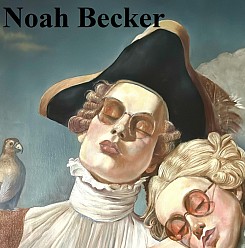Whitehot Magazine
December 2025
"The Best Art In The World"
"The Best Art In The World"
December 2025
March 07/ WM issue #1: Opening of Tomasz Kowalski and Anna Orlikowska

Last Friday night continued Mitte’s transformation into an outpost of trendy twenty-somethings from new EU member states, when Zak Gallery filled with young Poles celebrating a coming-out party of sorts for their contemporaries. At 22, painter Tomasz Kowalski has already garnered acclaim in his hometown of Kracow, but this is his first solo show outside of . The slightly more seasoned Anna Orlikowska, 27, with whom Kowalski shares Zak’s small space, has been living in Berlin since 2006 on a Deutsche Bank stipend but this is also her first German solo.
So, can the kids hack it? They certainly can. Kowalski’s aptly titled series “Painting is a Hungry Ghost” presents canvases that seem to have devoured the entire canon and spit it back out in a pleasing, mystical mix. Holbein’s portraiture, Bosch’s bizarre agglomerations, and Kahlo’s surreal splicing of body-machine dynamics all come to mind. Setting oddly-garbed figures in an inscrutable and melancholy country landscape, often with a dabble of daintily-painted insects, Kowalski plays not only with dream-like referentiality but also with the viewer’s art-historical memory album. That his work is derivative doesn’t detract, however, from its hypnotic, carefully choreographed strangeness, for example in large untitled work where a machine is depicted in the act of creating the work on the gallery wall opposite, with a handful of spiders thrown in for good measure.
Orlikowska also shows affection for creepy-crawlies in her mixed-media corner of video, photography, and sculpture. A screen plays a video loop of rhythmically wriggling worms alongside two large photographs of the earth in which these critters presumably live. The fine line between artificial and natural is being examined here; the video is viscerally creepy but not quite organic in its obvious orchestration, while even the seeming pattern in the richly-textured dirt suggests manipulation. Nearby, a large photograph of broken plates and glasses is complemented by a sculpture composed of a physical cabinet housing the same. The artist suggests an aesthetic solution to the problem of worthless stuff, as well as re-displaying the interest in pattern and repetition seen in the worm and dirt works.
The gallery, which opened in June 2006 and focuses on contemporary Eastern European art by young and largely unknown artists, is named after owner Asia {ak, but the name was also chosen because it is “very easy to remember and very Polish.” The same can be said of the young talent represented here, whose poignant re-imagining of Communist high-rises and grim urban scenery (last month’s “Gallery for Wintertime” group show), riffing on the Catholic clergy (in several of Kowalski’s strange compositions), or deconstructing acquisitive clutter (Orlikowska), evoke a distinctly ex-Eastern Bloc navigation of contemporary life. This show has its rough patches, to be sure, such as Kowalski’s unrefined line and exposed brushstroke, which work not at the service of his otherworldly aesthetic but rather betray a seeming lack of virtuosity. Yet {ak’s goal is not to put on view anointed masters but rather present what the art world daintily calls “emerging talent”—i.e. artists with one foot still firmly in the experimental classroom, waiting to graduate to their own self-confident style. The Kowalski / Orlikowska pairing amply meets this aim, allowing the gallery to become not just a way station for the artists but also a window on their fresh creativity for visitors.

Arden Pennell
Arden Pennell is a freelance journalist living in Berlin with a DAAD stipend. She writes for Deutsche Welle and Exberliner, among others. She received a B.A, Honors with Distinction, in art history from Stanford University and is currently doing post-graduate work at Humboldt University.










